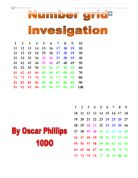If we call the top left number n, we can then convert the other numbers into algebra from n. With the top left been called n, the top right is 1 across the grid, and therefore n+1. The bottom left is 10 more than n and therefore becomes n+10. The bottom right is across one (1 more) and then down one (10 more) therefore becomes n+11 to get:
By multiplying the diagonals we would get:
n x (n+11) = n2 + 11n
(n+1) x (n+10) = n2 + 11n + 10
n2 + 11 will cancel out to always leave + 10, this proves that the difference will always be 10.
As we now know that no matter where the 2x2 square is put on the grid, the difference between the 2 products will always be 10, why is 10 significant?
If we go back to why we added 10, we see it was because we went vertically down on the grid:
10 is also the width of the grid, on a 11x11 grid is 11 added?
11 is added as you go vertically down the grid
Here we see that the number added vertically is the width of the grid. As 10 is the width of the grid we can substitute this into the equation by representing the width as w
n x (n+w+1) = n2 + nw + n
(n+1) x (n+w) = n2 + nw + n + w
As n2 + nw cancels out, the difference will always be w, which is the width of the grid
3x3 square
1 x 23 = 23
3 x 21 = 63
Difference = 40
71 x 93 = 6603
73 x 91 = 6643
Difference = 40
78 x 100 = 7800
80 x 98 = 7840
Difference = 40
8 x 30 = 240
10 x 28 = 280
Difference = 40
We can turn the values found in the 3x3 square into albegra:
n x (n+2w+2) = n2 + 2nw + 2n
(n+2) x (n+2w) = n2 + 2nw + 2n + 4w
Here the difference will always be 4w
4x4 square
1 x 34 = 34
4 x 31 = 124
Difference = 90
61 x 94 = 5734
64 x 91 = 5824
Difference = 90
67 x 100 = 6700
70 x 97 = 6790
Difference = 90
7 x 40 = 280
10 x 37 = 370
Difference = 90
n x (n+3w+3) = n2 + 3nw + 3n
(n+3) x (n+3w) = n2 + 3nw + 3n + 9w
Clearly, the difference will always be 9w.
If we look back to our results we see that the difference is:
- 2x2 grid = w
- 3x3 grid = 4w
- 4x4 grid = 9w
We now have to find why that is the difference.
In the algebra formulas all variables were giving an algebraic letter except the number added to n (n+1, n+2, n+3 etc.)
On a 2x2 grid the number added is 1
On a 3x3 grid the number added is 2
On a 4x4 grid the number added is 3
The number added to n is the length of the square minus 1. We can then convert this value into algebra:
If we represent the length of the square as l then the number added would be (l –1)
n (n +3w+(l –1)) = n2 + 3nw + (l –1)n
n+(l –1) x n +(l –1)w = n2 + 3nw + (l –1)n + (l –1) 2w
The difference of any size square of numbers is:
W(l –1)2 i.e width of the grid x ((the length of the square - 1) squared)
Checking the formula
With the formula W(l –1)2 we should be able to find the difference on any size grid and any size square.
Grid 14x14, square 8x8
By using the formula, the difference should be:
W(l –1)2 = 14 (8-1) 2
= 686
Check:
61x166 = 10126
68x159 = 10812
Difference does equal 686
Grid 7x7, square 7x7
By using the formula, the difference should be:
W(l –1)2 = 7 (7-1) 2
= 252
Check:
1x49 = 49
7x43 = 301
Difference does equal 252








